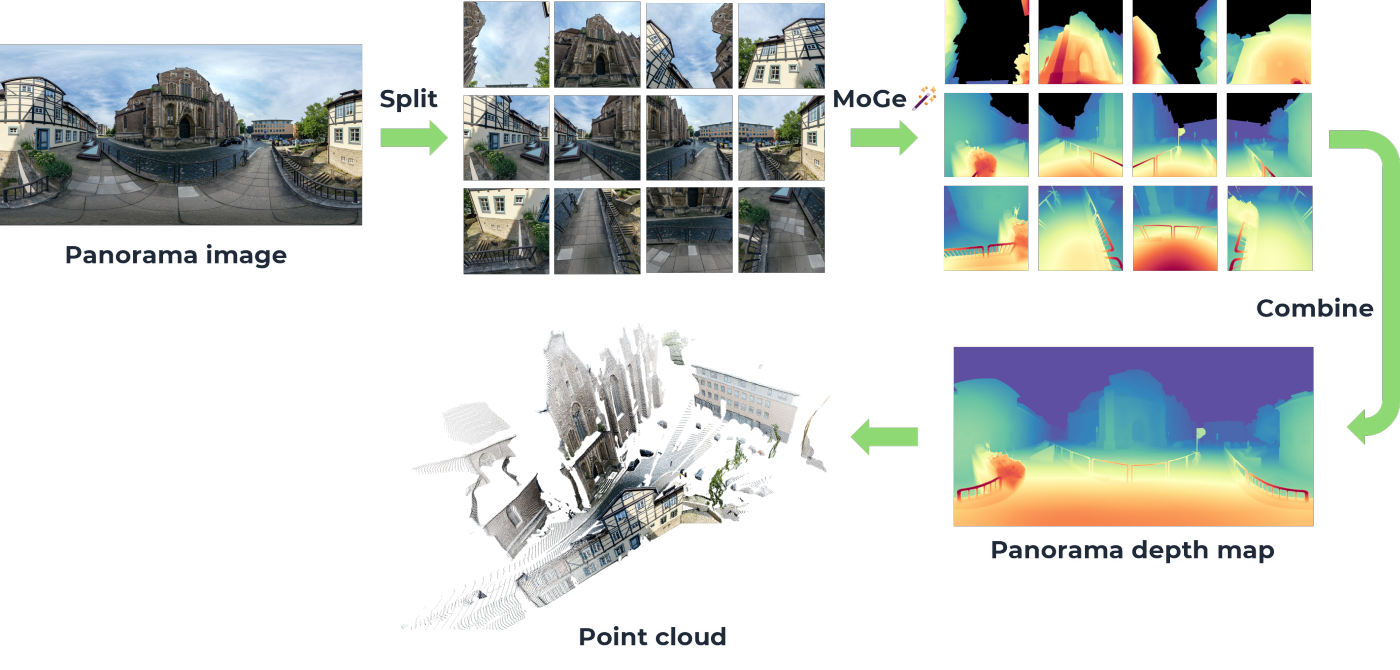MoGe is a powerful model for recovering 3D geometry from monocular open-domain images. The model consists of a ViT encoder and a convolutional decoder. It directly predicts an affine-invariant point map as well as a mask that excludes regions with undefined geometry (e.g., sky), from which the camera shift, camera focal length and depth map can be further derived.
Check our website for videos and interactive results!
- Accurately estimate 3D geometry in point map or mesh format from a single image.
- Support various image resolutions and aspect ratios, ranging from 2:1 to 1:2.
- Capable of producing an extensive depth range, with distances from nearest to farthest reaching up to 1000x.
- Fast inference, typically 0.2s for a single image on an A100 or RTX 3090 GPU.
- Release inference code & ViT-Large model.
- Release ViT-Base and ViT-Giant models.
- Release evaluation and training code.
🌟Updated on 2024/11/28 - CHANGELOG:
- Supported user-provided camera FOV.
- Added the script for panorama images scripts/infer_panorama.py.
-
Clone this repository.
git clone https://github.com/microsoft/MoGe.git cd MoGe -
Python (>= 3.10) environment:
- torch (>= 2.0) and torchvision (compatible with the torch version).
- other requirements
MoGe should be compatible with most requirements versions. Please check the
pip install -r requirements.txt
requirements.txtfor more details if you have concerns.
The ViT-Large model has been uploaded to Hugging Face hub at Ruicheng/moge-vitl.
You may load the model via MoGeModel.from_pretrained("Ruicheng/moge-vitl") without manually downloading.
If loading the model from a local file is preferred, you may manually download the model from the huggingface hub and load it via MoGeModel.from_pretrained("PATH_TO_LOCAL_MODEL.pt").
Here is a minimal example for loading the model and inferring on a single image.
import cv2
import torch
from moge.model import MoGeModel
device = torch.device("cuda")
# Load the model from huggingface hub (or load from local).
model = MoGeModel.from_pretrained("Ruicheng/moge-vitl").to(device)
# Read the input image and convert to tensor (3, H, W) and normalize to [0, 1]
input_image = cv2.cvtColor(cv2.imread("PATH_TO_IMAGE.jpg"), cv2.COLOR_BGR2RGB)
input_image = torch.tensor(input_image / 255, dtype=torch.float32, device=device).permute(2, 0, 1)
# Infer
output = model.infer(input_image)
# `output` has keys "points", "depth", "mask" and "intrinsics",
# The maps are in the same size as the input image.
# {
# "points": (H, W, 3), # scale-invariant point map in OpenCV camera coordinate system (x right, y down, z forward)
# "depth": (H, W), # scale-invariant depth map
# "mask": (H, W), # a binary mask for valid pixels.
# "intrinsics": (3, 3), # normalized camera intrinsics
# }
# For more usage details, see the `MoGeModel.infer` docstring.Using scripts/app.py for a web demo
Make sure that gradio is installed and then run the following command to start the web demo:
python scripts/app.py # --share for Gradio public sharingThe web demo is also available at our Hugging Face space.
Using scripts/infer.py
Run the script scripts/infer.py via the following command:
# Save the output [maps], [glb] and [ply] files
python scripts/infer.py --input IMAGES_FOLDER_OR_IMAGE_PATH --output OUTPUT_FOLDER --maps --glb --ply
# Show the result in a window (requires pyglet < 2.0, e.g. pip install pyglet==1.5.29)
python scripts/infer.py --input IMAGES_FOLDER_OR_IMAGE_PATH --output OUTPUT_FOLDER --showFor detailed options, run python scripts/infer.py --help:
Usage: infer.py [OPTIONS]
Inference script for the MoGe model.
Options:
--input PATH Input image or folder path. "jpg" and "png" are
supported.
--fov_x FLOAT If camera parameters are known, set the
horizontal field of view in degrees. Otherwise,
MoGe will estimate it.
--output PATH Output folder path
--pretrained TEXT Pretrained model name or path. Default is
"Ruicheng/moge-vitl"
--device TEXT Device name (e.g. "cuda", "cuda:0", "cpu").
Default is "cuda"
--resize INTEGER Resize the image(s) & output maps to a specific
size. Default is None (no resizing).
--resolution_level INTEGER An integer [0-9] for the resolution level of
inference. The higher, the better but slower.
Default is 9. Note that it is irrelevant to the
output resolution.
--threshold FLOAT Threshold for removing edges. Default is 0.03.
Smaller value removes more edges. "inf" means no
thresholding.
--maps Whether to save the output maps and fov(image,
depth, mask, points, fov).
--glb Whether to save the output as a.glb file. The
color will be saved as a texture.
--ply Whether to save the output as a.ply file. The
color will be saved as vertex colors.
--show Whether show the output in a window. Note that
this requires pyglet<2 installed as required by
trimesh.
--help Show this message and exit.
Using scripts/infer_panorama.py for 360° panorama images
NOTE: This is an experimental extension of MoGe.
The script will split the 360-degree panorama image into multiple perspective views and infer on each view separately. The output maps will be combined to produce a panorama depth map and point map.
Note that the panorama image must have spherical parameterization (e.g., environment maps or equirectangular images). Other formats must be converted to spherical format before using this script. Run python scripts/infer_panorama.py --help for detailed options.

The photo is from this URL
MoGe code is released under the MIT license, except for DINOv2 code in moge/model/dinov2 which is released by Meta AI under the Apache 2.0 license.
See LICENSE for more details.
If you find our work useful in your research, we gratefully request that you consider citing our paper:
@misc{wang2024moge,
title={MoGe: Unlocking Accurate Monocular Geometry Estimation for Open-Domain Images with Optimal Training Supervision},
author={Wang, Ruicheng and Xu, Sicheng and Dai, Cassie and Xiang, Jianfeng and Deng, Yu and Tong, Xin and Yang, Jiaolong},
year={2024},
eprint={2410.19115},
archivePrefix={arXiv},
primaryClass={cs.CV},
url={https://arxiv.org/abs/2410.19115},
}



